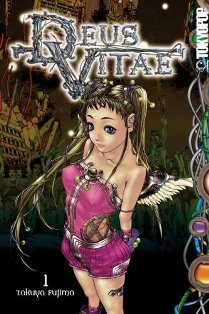
First published back in July of 2004, ‘Deus Vitae: Volume I’ formed the first instalment in the Deus Vitae Trilogy by Manga writer and artist Takuya Fujima.
DLS Synopsis:
Programmed using the sum of human knowledge, the Argus Computer was built to protect humanity. Instead, it created Leave – the ultimate weapon and mother to a new master race. On her first day of existence, the Goddess Leave destroyed mankind. On the second day, the Selenoid androids were born. The Selenoid were to be a more perfect creature than those that had ruled the planet before them. But in her wisdom, Leave created others as well. The less-perfect. Designed from mankind, the Selenoid used the less-perfect as slaves. But the slaves rose up against their masters, calling their rebellion the Revolution Organisation (or as it became more commonly known – the Re-O).
It’s now 2068 and the only threat to this new world order comes from the surviving members of mankind. Ash Lamy is one of these few remaining humans. However, when he kills the Control Director Markus Viraldi – a particularly high-ranking Selenoid – Lamy is captured by Shee Viona, the Vice-Commander of the Bureau of Defence and bodyguard to Mother Seishia.
Despite his crimes, Shee Viona decides to spare the human his life. For the bodyguard sees great power and strength within Ash Lamy. Power that the Selenoid wish to harness for their own gain.
The future looks increasingly bleak for mankind. The Re-O forces are few. If they are to free Earth from Selenoid rule, they will need help from somewhere. Maybe, just maybe, such help could come from within the Selenoid themselves. From those that sympathise with mankind’s plight.
In a world of artificiality, the question now is: can love be the saviour of a dying race?...
DLS Review:
Manga and dystopian fiction go together like frigging cheese and pickle. It’s a veritable match made in heaven. So seeing thsat Manga artist and writer Takuya Fujima has employed this style of story with his Deus Vitae Trilogy comes as little surprise.
In essence what we have is humanity pretty much wiped out by our own technology, only to be replaced by this apparently near-perfect Selenoid race of androids. Of course we have pockets of resistance. The few remaining humans aren’t going down without a goddam fight. In walks Ash Lamy. Our sword-wielding effortlessly heroic protagonist, who knows how to kick some serious ass when the situation calls for it.
There’s a lot more going on in the background. We have a veritable latticework of relatively complex mythology constructed by Fujima. The world is now comprised of four lands. For each land there is a Blessed Mother who rules their respective land under the guidance and overseeing rule of the almighty Leave. Indeed, there’s a well carved out hierarchy to almost every aspect of the story, which you see coming into play over and over again.
Although there’s a reasonably elaborate backstory behind it all, the plot for this first volume is actually quite simplistic. Nevertheless, it toys with a number of open-ended questions and ideas about artificiality, what it is to be human, class hierarchy, and the possible relationships between man and a creation that’s not entirely of natural making.
There’s violence and explosions in dribs and drabs throughout the length of this first volume. Nothing overly in your face, more a beating pulse that reminds you this is proper Manga with a consistent rhythm that’s maintained from start to finish.
Being Manga, there’s a few aspects that are a tad weird and unexplained. Why Mother Seishia ultimately wishes to fuse with Ash Lamy is pretty much anyone’s guess. Similarly, in this first volume at least, the connection Lamy has with the Selenoid Lemiu Winslet is again, not altogether explained. Nevertheless it all charges onwards with a textbook Manga flow to it. Always flirting with a hint of a spiritual platform, but never wholly committing to such.
There’s also a good helping of reasonably risqué sexiness to the story. In fact, there are very few pages where a hot Selenoid hasn’t gotten her bouncing breasts out. Even when covered, the skin-tight garments leave little to the imagination, with large constantly erect nipples threatening to poke people’s eyes out here, there and everywhere. The Goddesses are also particularly scantily clad, with the very minutest of wafer-thin fabrics the only thing covering their delicate lady areas.
It’s certainly got a lot of potential in it. It’s all textbook Manga with plenty of complimentary elements working in its favour. However, there’s something that does feels missing. A slightly diluted energy and noticeably lack of direct urgency to most parts. Yeah, we get that mankind’s on the brink of utter extinction, but the threat still doesn’t feel that devastating. It’s just a tad too toned down. Nothing spectacularly tense or volatile. Nothing that explodes in your face with desperation. It’s like Terry Gilliam’s ‘12 Monkeys’ (1995) without the infectious energy of Bruce Willis’ character within it.
For the last 46 pages of the book, Fujima offers up a reasonably lengthy prologue which flings us back to the early days of the Argus Computers rule which ended up unleashing WWIII upon the world. Here we witness Dr Fenril’s ingrained love for the daughter he created – the Goddess that would become Leave – and how this will gradually become the new world order. Indeed, the prologue helps to lay down a firmer, more concrete foundation for the story to grow upon – giving Leave a more complex and elaborately intriguing backstory that sits well with the direction the whole story’s moving towards. Without this prologue we’d probably be missing a critical chunk from the broader story’s foundations.
The graphic novel runs for a total of 200 pages.

© DLS Reviews
Other ‘Deus Vitae’ instalments:
- ‘Deus Vitae: Volume I’ (2004)
- ‘Deus Vitae: Volume II’ (2004)






